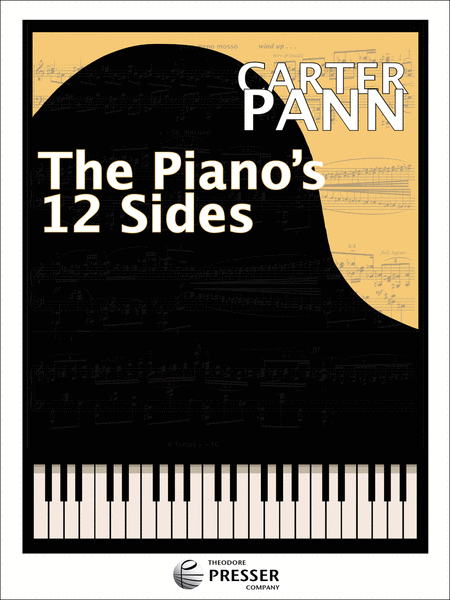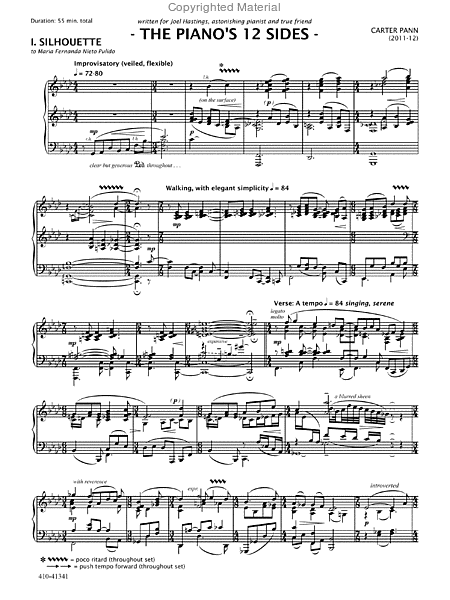Details
Description
SKU: PR.410413410
Composed by Carter Pann. Sws. Contemporary. Solo part. With Standard notation. Composed 2012. 68 pages. Duration 55 minutes. Theodore Presser Company #410-41341. Published by Theodore Presser Company (PR.410413410).ISBN 9781598064469. UPC: 680160610969. 9x12 inches.
An outstanding pianist himself, Carter Pann has created The Piano's 12 Sides, an hour-long collection of 12 movements each developing a color or character. The work's magnificence exudes both from the beauty and dazzle of each "side," and from this monumental structure in which each movement stands out from the rest, yet all 12 build to an integrated whole. For advanced pianists.
PROGRAM NOTES by the composerIn the summer of 2011 Joel Hastings and I were talking on the phone (our seasonal call), and I proposed writing a book of twelve solo works for him to perform as a set sometime in the near future. The idea struck me in that instant as one of the best musical ideas I’ve had, for Joel is a consummate musician/pianist. I don’t mean that Joel is a very good pianist, I mean he is a rare species in the music world – possessing huge helpings of raw piano talent, musical soul, and world-class refinement in perfect combination.I have worked closely with some truly marvelous pianists over the years, but this was an idea in which I was hoping to collaborate with a single artist over a great expanse of music. It was a true moment for providence when I think back to that phone call. I am one lucky composer for knowing Joel – and for having the friends (all pianists) for whom each of the pieces is individually dedicated below.I. SILHOUETTE to Maria Fernanda Nieto PulidoThis large poem for piano found its place at the beginning of the set, as it embodies many of the qualities and contains the representative ingredients to be found throughout the entire set. The piece opens somewhat nebulously, and only when the verse first appears is it apparent that everything before was introductory. The piece is strophic, and the original verse does return, only acting to ground the listener after such indulgent departures are heard as the work unfolds. Nearing the conclusion brings about a dominant pedal of nefarious character before the tonic is driven with greater and greater persistence to the end. For the nal gesture the performer is asked to play a brilliant upward scale in the right hand against a glissando in the left, to bring the music to its conclusion in a register rarely heard throughout the piece.II. FIGURINES to Peter CollinsOn the surface, it appears that there are two separate, unrelated musics presented in Figurines – hyper-virtuosic, upper-register “! ourish” music and a Perpetual March. There is something attractive to my composer inclinations about this presumed disparity. However, upon further and deeper delving one can extract the glue that relates the two elements to one another. Marked as a “virtuosic improvisation,” the pianist is forbidden from the very beginning to indulge in certain human musical tendencies: “rubato and agogic are illegals.” There is a joie de vitesse to Figurines that no other work from the set embodies. This piece is for the fearless musician – the pianist who is willing to control the instrument to serve his/her whim from start to finish. There is nothing elegant about the Perpetual March which serves as the centerpiece for the movement. You must push yourself through to the other side (and your left hand had better be up to the task).III. LEGEND to Rob AulerThis introspective andantino piece is a modal study in tight voice-leading. The opening 3-note scalar motive (G-F#-E) is an adhesive that keeps the work from unraveling. The ending presents its darker sibling (G-F-E), droning as the beginning. The very last gesture of the piece shows this dark version of the motive turned upside down and inthe Dorian mode. Overall there is a foreign, somewhat exotic sentiment about this smalltwo-page expression.IV. WHITE MOON OVER WATER to Avguste AntonovThe title refers to an experience I had on the Damariscotta River in Maine in the summerof 2010. I took a one-person kayak out on the great, wide river in the middle of the night. Not a cloud in the sky, my only companions were a blinding full moon, an imposing pale-white Venus, and thousands of visible stars. I am not used to creating the kind of musical expression this piece demands, so the process was both inescapable and thrilling.Without a melodic line to anchor oneself on, I ask the pianist to use the instrument like a canvas over which many different color combinations are applied evenly throughout. The amount of restraint required to achieve this is formidable. The work’s interior (“The Celestial Canopy”) pulls one into a timeless realm. In this section no tempo should be felt by the listener – only a sense of eternal suspension.V. LE BRANLE to Ryan MacEvoy McCulloughA branle is a 12th-century French chain dance adopted by the European aristocracy in which the dancers alternated large sideways steps to the left with an equal number of smaller steps to the right. Anglicized as “brawl,” the dance usually consisted of couples intertwining arms or holding hands and progressing to the left in a circular or serpentine" figure. Branles would involve running, walking, gliding, or skipping steps depending on the tempo of the music, which was composed in a 4/4 time.Composed in 12/8 time, this fast Branle is a moto perpetuo wherein the direction to the performer is, “More drive, less swagger.” As this weird motoric piece pushes further and further ahead there is that sense of a brawl instead of a dance. Two elements are in argument throughout: the opening material and a repeated-note section. The second occurrence of the repeated-note section sounds as if it is sweetly pleading to win over the stern insistence of the " first theme. Too bad… it doesn’t. The work closes with a playful but goading whistle of the original theme.VI. CLASSIC ROCK to Jack GaffneyI met Jack Gaffney when he had just turned twelve years old. We started working together on music theory lessons at the time, and these transformed quickly into songwriting lessons. Jack is a natural songwriter and pianist. His talent is undeniable. This young man (now sixteen years old) has books full of original songs with original lyrics. He andI have had some great moments together working to tighten up certain verses, craft better choruses, choose better words, shape better hooks, etc. Many, many songs and two albums later Jack is now writing songs on a whole different level. I’m filled with pride just thinking about some of the work and growth we were able to accomplish together. I’ve learned a lot from Jack, and the sixth piece of this set is dedicated to him as an expression of my gratitude to him and to his parents and siblings, all of whom constitute the consummate family. The opening and ending are unmistakable nods to apast composer, but aside from that it’s all classic rock.VII. SHE STEALS ME to Kristin KusterThis song, subtitled intermezzo, owes some of its concepts to Schubert and Stravinsky. The work is cast as a plaintive Appalachian waltz in A-# at major with occasional passionate chorale-like proclamations. There is a real introverted sadness about a few of the moments in this piece, while at other times there are descriptive words and phrases on the page as “…a rocking chair on the porch,” and “snowing…” Whenever I play through the piece I come terribly close to tears in all the same spots. The softie in me could not resist preserving these moments, even at the expense of obvious sentimentality.VIII. SOIRÉE MACABRE to Nikki MelvilleA piece of haunted salon music, imagine a cadaverous Vincent Price playing this ragged ghost-waltz to an audience of zombie socialites milling about at the grand escalier, a monstrous old chandelier hanging sentinel above the fray. The harmonies are blood-soaked and often imbued with hidden malevolence, mixing extravagance with the sinister.IX. ORION to Hsing-ay HsuGiving the pianist an opportunity for pure, uninterrupted listening, the opening is a single! owing line for the right hand. As each version of the opening single line progresses the range expands, the quantity of notes increases, the tempo brightens. As in White Moon Over Water this piece inhabits a cosmic realm. Time signatures are missing throughout, and there are no bar lines – only notes to be brushed over with fleeting moments of tension followed obligingly by release. The more I play this piece the greater becomesits likeness to a yet-unwritten Debussy prelude.X. CRADLE SONG to Marina LomazovA dark lullaby, the rocking begins and the melody enters on a third stave (acting as a vocal line over piano accompaniment). Often times the vocal line gets intertwined with the rocking and the pianist must take care to preserve the line accordingly. This little piece is a study in voicing as lines of varying importance sometimes land on top of eachother.XI. GRAND ETUDE-FANTASY to Winston ChoiEvery element of this piece is ambitious. Only a masterful pianist familiar with the quick juxtapositions found in more contemporary works can hope to pull it off . I know I will never be able to perform this piece, and that fact fills me with frustration. I recently talked about this work as being a bi-tonal exploration of Bachian frenzy. The description is apt. There is a small melodic fragment of a certain shape that represents spinning out of control (i.e., two adjacent pitches expanding melodically, getting further fromone another quickly), and this ingredient pervades much of the work, though there are departures into wholly different sections. The form of this piece could be characterized as a loose Rondo, though I believe Fantasy is a better, more sympathetic fit as the previously mentioned juxtapositions are less in keeping within the more rigid, traditional Rondo form.XII. AN IRISH TUNE to Barry SnyderThe composer’s own arrangement of the traditional Irish Tune from County Derry, orLondonderry Air, the mood is hushed giving a sense of finality to the set. At the climax of the second verse the pianist might imagine a gospel choir at the height of glorious pronouncement.


 Share
Share